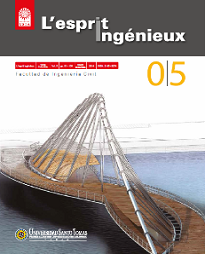Caracterización y recurrencia sísmica del nido de Bucaramanga
Main Article Content
Abstract
In this paper the seismic recurrence of the Bucaramanga Seismic Nest is calculated from the analysis of seismic events in the area between May 2012 and February 2013. This analysis was carried out using the probabilistic method of synthetic seismograms complemented with a deterministic method to estimate the energy released. Also, the characterization of the area known as the “Bucaramanga Seismic Nest” was achieved. Finaly, the area is delimited with similar characteristics, the density of accumulated fault planes is determined and the high seismic activity in the area is denoted.
Article Details
How to Cite
Perico-Martínez, N. R., & Perico-Granados, N. R. (2016). Caracterización y recurrencia sísmica del nido de Bucaramanga. L’esprit Ingénieux, 5(1). Retrieved from http://revistas.ustatunja.edu.co/index.php/lingenieux/article/view/1236
Section
Articulos L'esprit Ingénieux 05
References
Buforn, E. y Pro, Carmen (2006). Mecanismo focal y sismotectónica. aportación de Agustín Udías. Física de la Tierra, 18, 11-23.
Casella, G. y Berger, R. (2002). Statistical inference (2.a ed.). Pacific Grove: Thomson Learning.
Chen, Y., Zhou, R. y Wu, Z. (1999). Moment tensor inversion for focal mechanism of the Beibuwan earthquakes. Acta Seismologica Sinica, 12(6), 609-617.
Congreso de la República, Asociación de Ingeniería Sísmica (2010). Norma Sismo Resistente Colombiana NSR-10. Bogotá: Autor.
Guttenberg, B. y Richter, C. F. (1956). Magnitude and energy of earthquakes. Annali di Geofisica, 9, 1-15.
Grupo Quimbaya y CEIFI (2014). Tasas de recurrencia sísmica en la zona central de los andes colombianos a partir de la completitud del catálogo hasta el año 2004. Arenia: Universidad del Quindío.
Hanks, T. C. y Kanamori, H. (1979). A moment magnitude scale. Journal of Geophysical Research, 84, 23480-23500.
Helmstetter, A. y Jackson, D. (2005). Importance of small earthquakes for stress transfers and earthquake triggering, J. Geophys.
Sistema Geológico de Colombia (s. f.). Formulario de consulta externa de sismos. Recuperado dehttp://goo.gl/syKpTl
Lehmann, E .L. (2005). Testing Statistical Hypotheses (3.a ed.). Nueva York: Springer. Parsons, T. y Velasco, A. A. (2011). Absence of remotely triggered large earthquakes beyond the mainshock region. Nat Geosci, 4, 312-316.
Seyrek, E., y Tosun, H. (2011). Deterministic approach to the seismic hazard of dam sites in Kızılırmak basin, Turkey. Natural Hazards, 59(2): 787-800.
Stein, S. y Wysession, M. (2003). An introduction to seismology, earthquakes, and Earth structure. Hong Kong: Graphicraft Limitada.
Wald, D. J. et al. (1999). TriNet “ShakeMaps”: rapid generation of peak ground motion and intensity maps in California. Earthquake Spectra, 15, 537–556.
Wells, D. L., y Coppersmith, K. J. (1994). New empirical relationships among magnitude, rupture area and surface displacement. Bull. Seism. Soc. Am., 84(4), 974-1002.
Wiemer, S. (2000). Introducing probabilistic aftershock hazard mapping. Geophysical Research Letters, 27(20), 3405-3408.
Casella, G. y Berger, R. (2002). Statistical inference (2.a ed.). Pacific Grove: Thomson Learning.
Chen, Y., Zhou, R. y Wu, Z. (1999). Moment tensor inversion for focal mechanism of the Beibuwan earthquakes. Acta Seismologica Sinica, 12(6), 609-617.
Congreso de la República, Asociación de Ingeniería Sísmica (2010). Norma Sismo Resistente Colombiana NSR-10. Bogotá: Autor.
Guttenberg, B. y Richter, C. F. (1956). Magnitude and energy of earthquakes. Annali di Geofisica, 9, 1-15.
Grupo Quimbaya y CEIFI (2014). Tasas de recurrencia sísmica en la zona central de los andes colombianos a partir de la completitud del catálogo hasta el año 2004. Arenia: Universidad del Quindío.
Hanks, T. C. y Kanamori, H. (1979). A moment magnitude scale. Journal of Geophysical Research, 84, 23480-23500.
Helmstetter, A. y Jackson, D. (2005). Importance of small earthquakes for stress transfers and earthquake triggering, J. Geophys.
Sistema Geológico de Colombia (s. f.). Formulario de consulta externa de sismos. Recuperado dehttp://goo.gl/syKpTl
Lehmann, E .L. (2005). Testing Statistical Hypotheses (3.a ed.). Nueva York: Springer. Parsons, T. y Velasco, A. A. (2011). Absence of remotely triggered large earthquakes beyond the mainshock region. Nat Geosci, 4, 312-316.
Seyrek, E., y Tosun, H. (2011). Deterministic approach to the seismic hazard of dam sites in Kızılırmak basin, Turkey. Natural Hazards, 59(2): 787-800.
Stein, S. y Wysession, M. (2003). An introduction to seismology, earthquakes, and Earth structure. Hong Kong: Graphicraft Limitada.
Wald, D. J. et al. (1999). TriNet “ShakeMaps”: rapid generation of peak ground motion and intensity maps in California. Earthquake Spectra, 15, 537–556.
Wells, D. L., y Coppersmith, K. J. (1994). New empirical relationships among magnitude, rupture area and surface displacement. Bull. Seism. Soc. Am., 84(4), 974-1002.
Wiemer, S. (2000). Introducing probabilistic aftershock hazard mapping. Geophysical Research Letters, 27(20), 3405-3408.

